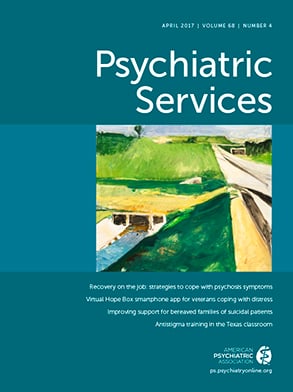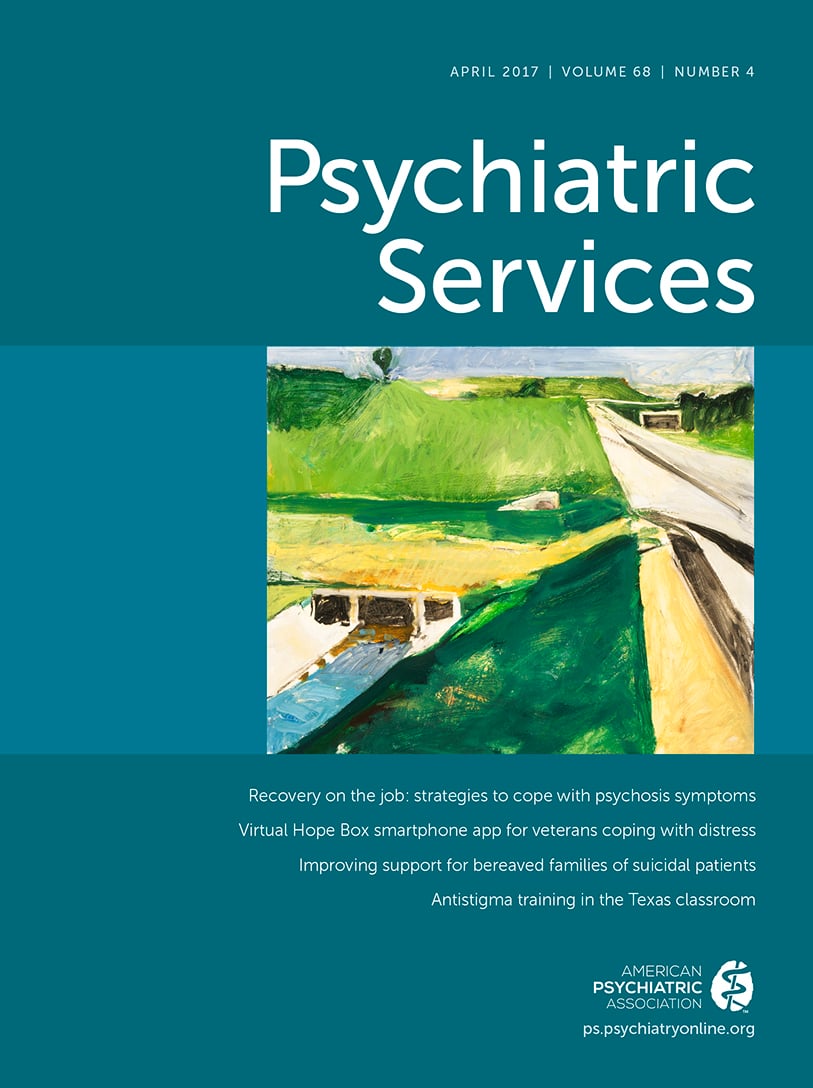Outcomes of a Psychoeducational Intervention to Reduce Internalized Stigma Among Psychosocial Rehabilitation Clients
Abstract
Objective:
Methods:
Results:
Conclusions:
The Ending Self-Stigma Program
Methods
Intervention Condition: ESS
Control Condition: Minimally Enhanced Treatment as Usual
Interviews, Randomization, and Measures
Data Analysis
Results
Sample
| All (N=268) | ESS (N=131) | Control (N=137) | |||||||
|---|---|---|---|---|---|---|---|---|---|
| Variable | Total N | N | % | Total N | N | % | Total N | N | % |
| Psychiatric diagnosis | 258 | 125 | 133 | ||||||
| Bipolar | 70 | 27 | 39 | 31 | 31 | 23 | |||
| Depression | 23 | 9 | 7 | 6 | 16 | 12 | |||
| Schizophrenia | 79 | 31 | 37 | 30 | 42 | 32 | |||
| Schizoaffective | 56 | 22 | 24 | 19 | 32 | 24 | |||
| Other | 4 | 2 | 2 | 2 | 2 | 2 | |||
| Depression with psychosis | 15 | 6 | 9 | 7 | 6 | 5 | |||
| Psychosis NOS | 11 | 4 | 7 | 6 | 4 | 3 | |||
| Age | 268 | 44.7±12.3 | 131 | 43.7±12.9 | 137 | 45.7±11.8 | |||
| Male | 268 | 163 | 61 | 131 | 85 | 65 | 137 | 78 | 57 |
| Currently married | 267 | 13 | 5 | 130 | 7 | 5 | 137 | 6 | 4 |
| ≥12 years of education | 267 | 184 | 69 | 130 | 87 | 67 | 137 | 97 | 71 |
| Veteran | 268 | 14 | 5 | 131 | 6 | 5 | 137 | 8 | 6 |
| Hispanic | 268 | 11 | 4 | 131 | 2 | 2 | 137 | 9 | 7 |
| African American | 266 | 124 | 47 | 130 | 60 | 46 | 135 | 64 | 47 |
| First received treatment for emotional or mental health problem (M±SD age) | 264 | 22.1±11.6 | 129 | 21.5±11.9 | 135 | 22.8±11.4 | |||
| Brief Symptom Inventory Global Severity Index (t score) (M±SD)a | 267 | 44.4±9.2 | 131 | 44.8±8.9 | 136 | 44.0±9.5 | |||
| Experiences of Stigma Survey (M±SD score)b | |||||||||
| Stigma scale | 266 | 18.3±6.0 | 130 | 19.0±5.7 | 136 | 17.6±6.2 | |||
| Discrimination scale | 206 | 11.1±7.5 | 99 | 11.5±7.5 | 107 | 10.6±7.5 | |||
| Beck Cognitive Insight Scale (M±SD score)c | |||||||||
| Self-reflectiveness subscale | 264 | 21.8±4.3 | 130 | 21.9±4.2 | 134 | 21.7±4.3 | |||
| Self-certainty scale | 265 | 14.2±3.0 | 130 | 14.3±3.1 | 135 | 14.1±2.9 | |||
| Composite scale | 262 | 7.6±5.1 | 129 | 7.5±4.8 | 133 | 7.6±5.3 | |||
| Immediate Memory Index (M±SD score)d | 263 | 74.8±18.8 | 130 | 74.8±18.9 | 133 | 74.7±18.8 | |||
ESS Participation
Fidelity Results
Primary Outcome: Internalized Stigma
| Baseline | Postintervention | Follow-up | ||||||||||||||||||
|---|---|---|---|---|---|---|---|---|---|---|---|---|---|---|---|---|---|---|---|---|
| ESS (N=131) | Control (N=137) | ESS (N=122) | Control (N=131) | ESS (N=113) | Control (N=117) | |||||||||||||||
| Scale and subscale | M | SD | M | SD | M | SD | M | SD | Effect sizea | Test statistic | df | p | M | SD | M | SD | Effect sizeb | Test statistic | df | p |
| Self-Stigma of Mental Illness Scalec | ||||||||||||||||||||
| Awareness | 58.6 | 19.4 | 56.0 | 20.6 | 57.6 | 19.9 | 55.8 | 21.5 | .035 | .32 | 247 | .751 | 56.2 | 19.2 | 53.0 | 20.2 | .137 | 1.23 | 230 | .219 |
| Stereotype agreement | 32.8 | 16.1 | 30.4 | 15.8 | 28.4 | 14.5 | 32.6 | 17.4 | –.312 | –2.78 | 251 | .006 | 28.1 | 13.7 | 29.6 | 13.7 | –.138 | –1.17 | 228 | .245 |
| Self-concurrence | 24.1 | 14.6 | 23.2 | 13.2 | 20.5 | 12.9 | 23.5 | 12.9 | –.299 | –2.88 | 249 | .004 | 22.5 | 15.4 | 21.5 | 11.4 | .011 | .10 | 226 | .923 |
| Self-esteem decrement | 20.7 | 13.6 | 21.2 | 14.8 | 18.2 | 12.1 | 20.0 | 13.6 | –.132 | –1.27 | 248 | .204 | 19.7 | 14.7 | 19.1 | 12.0 | .042 | .35 | 230 | .725 |
| Internalized Stigma of Mental Illness–29d | ||||||||||||||||||||
| Alienation | 2.3 | .7 | 2.4 | .7 | 2.1 | .6 | 2.3 | .6 | –.185 | –2.05 | 252 | .041 | 2.1 | .6 | 2.2 | .6 | –.119 | –1.15 | 230 | .250 |
| Stereotype endorsement | 2.0 | .5 | 2.0 | .5 | 1.8 | .4 | 1.9 | .5 | –.051 | –.50 | 245 | .618 | 1.8 | .5 | 1.9 | .5 | –.126 | –1.05 | 234 | .295 |
| Discrimination | 2.4 | .6 | 2.5 | .6 | 2.3 | .6 | 2.3 | .5 | –.057 | –.58 | 253 | .565 | 2.2 | .5 | 2.3 | .6 | –.194 | –1.73 | 232 | .085 |
| Social withdrawal | 2.4 | .6 | 2.4 | .6 | 2.2 | .6 | 2.2 | .6 | –.001 | –.01 | 253 | .996 | 2.1 | .6 | 2.2 | .6 | –.099 | –.91 | 236 | .366 |
| Stigma resistance | 2.2 | .4 | 2.0 | .4 | 2.0 | .5 | 2.1 | .4 | –.266 | –2.33 | 252 | .021 | 2.0 | .4 | 2.0 | .5 | –.112 | –.88 | 230 | .381 |
| Total | 2.2 | .4 | 2.2 | .4 | 2.1 | .4 | 2.1 | .4 | –.139 | –1.52 | 252 | .131 | 2.0 | .4 | 2.1 | .4 | –.170 | –1.57 | 234 | .117 |
| Sense of Belonging Instrumente | ||||||||||||||||||||
| Psychological experience | 42.2 | 5.6 | 42.2 | 5.3 | 42.4 | 5.5 | 42.1 | 5.5 | .067 | .62 | 250 | .537 | 42.2 | 6.4 | 41.8 | 5.9 | .007 | .06 | 236 | .955 |
| Antecedents | 49.2 | 9.1 | 48.3 | 10.1 | 50.7 | 9.0 | 50.3 | 10.1 | –.003 | –.04 | 246 | .971 | 51.3 | 9.1 | 50.7 | 9.8 | –.010 | –.09 | 235 | .927 |
| General Self-Efficacy Scalef | 3.7 | .7 | 3.7 | .7 | 3.8 | .7 | 3.7 | .7 | .107 | 1.06 | 253 | .292 | 3.8 | .7 | 3.7 | .6 | .009 | .09 | 233 | .931 |
| Maryland Assessment of Recovery Scaleg | 98.9 | 16.6 | 98.2 | 18.3 | 101.5 | 14.8 | 97.8 | 17.3 | .177 | 2.09 | 252 | .037 | 102.9 | 17.4 | 100.1 | 16.9 | .114 | 1.12 | 235 | .265 |
Secondary Outcomes: Recovery and Psychosocial Variables
Exposure to ESS and Treatment Effect
Discussion and Conclusions
References
Information & Authors
Information
Published In

Cover: Freeway and Aqueduct, by Richard Diebenkorn, 1957. Oil on canvas. Gift of William and Regina Fadiman (M.86.68). Los Angeles County Museum of Art, Los Angeles. Digital image © 2017 Museum Associates/LACMA, Licensed by Art Resource, New York City.
History
Keywords
Authors
Funding Information
Metrics & Citations
Metrics
Citations
Export Citations
If you have the appropriate software installed, you can download article citation data to the citation manager of your choice. Simply select your manager software from the list below and click Download.
For more information or tips please see 'Downloading to a citation manager' in the Help menu.
View Options
View options
PDF/EPUB
View PDF/EPUBLogin options
Already a subscriber? Access your subscription through your login credentials or your institution for full access to this article.
Personal login Institutional Login Open Athens loginNot a subscriber?
PsychiatryOnline subscription options offer access to the DSM-5-TR® library, books, journals, CME, and patient resources. This all-in-one virtual library provides psychiatrists and mental health professionals with key resources for diagnosis, treatment, research, and professional development.
Need more help? PsychiatryOnline Customer Service may be reached by emailing [email protected] or by calling 800-368-5777 (in the U.S.) or 703-907-7322 (outside the U.S.).
